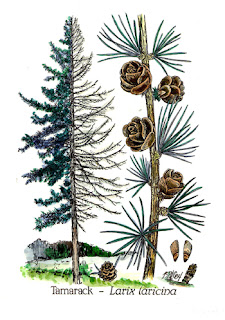 |
| My tamarack starts |
A few years ago I got my first look at the original c. 1834 survey maps of our county prior to the establishment of local government. The maps are really amazing and carry a great deal of detail you wouldn't expect. Sure, there was the Michigan Road and a few other blazed trails, mostly Indian trails, through the wilderness. Native American encampments were noted, one less than a mile northwest of our house, as well as a handful of pioneer trading posts and taverns.
Natural features are also noted on the map and make up the majority of items the surveyors recorded for history. Streams and wetlands, noteworthy trees and large stands of certain species were carefully placed on the large maps created in the nearly untouched wilderness.
 |
| Tamaracks in the fall |
It was one natural feature that caught my attention and made me question if it were accurate. Less than a quarter mile down my road, near its intersection with the Michigan Road was noted a "tamarack swamp". There were several of these pockets here and there across the map. I knew the area fairly well and it is still wet but now filled with silver maple and scrub elm. I hadn't realized until I did a little research that indeed tamarack trees, which resemble pines but lose their needles in the fall, were native to this part of the state and were survivors of the glacial age found in bogs.
The trees had medicinal and other consumable uses by Native Americans. The Chippewa word for the tree is "muckigwatig" which means "swamp tree". Now I wonder if "muck" have Native American roots. The tree would not have been plentiful in the county, so its qualities rendering it nearly indestructible to rot for fence posts and framing, probably sealed its fate.
 |
| Original range of the tamarack |
I had mentioned this "find" on the map to a client who has a great interest in forestry and he mentioned that he was in the process of growing tamarack from seed. He asked if I wanted to try an experiment if we could find suitable soils on my own property to grow them. Well sure, they could grow to be beautiful trees and could possibly start to repopulate the species now vanished from our county borders. So, I have three starts ready to be planted (and protected from deer) in a lowland area near our creek. I'll have to live a long time to see these reach significant maturity, but I'd like to think I'm helping to put things back into a natural order, and who knows, maybe there will be tamarack swamps again in our future.






4 comments:
I hope this goes well for you! I am sure the deer will be the biggest hurdle.
I know where there was one Tamarack in Marshall County, Tom Leggett and I ran across it while birding. It had very wet feet, perhaps sometime we can swing by there and see if it still there...........
There are still a few populations of tamarack in Marshall County. Nice project!
There are still a few populations of tamarack in Marshall County. Nice project!
A noble endeavor. May it go well.
Post a Comment